#Christabel Pankhurst
Text
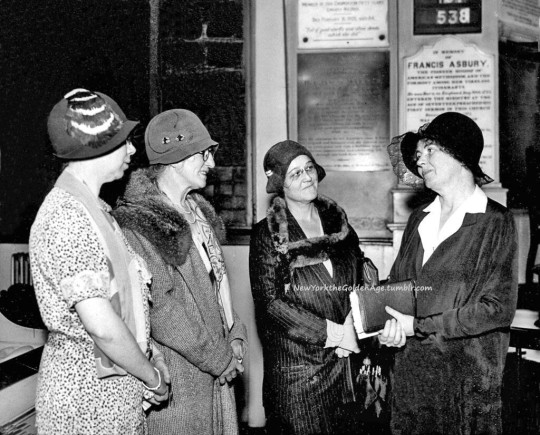
Christabel Pankhurst, right, the British-born suffragist and evangelist, speaks to three businesswomen at the John Street Methodist Church, October 30, 1931. Daughter of the famous suffragist Emmeline Pankhurst and radical socialist barrister Richard Pankhurst, she moved to the U.S. after World War I and became an evangelist for the Second Adventist Movement.
Photo: Associated Press
#vintage New York#1930s#Christabel Pankhurst#business women#suffragists#evangelist#Oct. 30#30 Oct.#1930s dress
19 notes
·
View notes
Text
On 19 February 1904 [Christabel Pankhurst] had attended a meeting in the Free Trade Hall in Manchester where Winston Churchill had spoken for an hour and a half (on the advantages of free trade), when she proposed an amendment to Churchill's resolution which would have the words expressed in the masculine gender in the Representation of the People Acts construed to include women. The Chairman refused to allow the amendment, but for quite some time Christabel would not give way. She was finally howled down, and for Christabel, this was ‘the first militant step - the hardest to me, because it was the first. To move from my place on the platform to the speaker's table in the teeth of the astonishment and opposition of will of that immense throng, those civil and county leaders and those Members of Parliament was the most difficult thing I have ever done’ (1959, p. 46). But the world did not end: the first and worst feat had been accomplished; the way was open to further 'militant' steps.
What Christabel discovered in the process was an insight not unknown to many of her foremothers (Florence Nightingale among them) even if not previously recognised by herself: that when women cease to be willing, men are either obliged to give way to women's demands or else they are required to demonstrate their greater power and force to keep women in their place. The manners of chivalry can only be maintained while women willingly abide by the restrictive rules men have imposed upon them; once women challenge those rules, chivalry is dead. It would be impossible for men to argue that women have all the rights and respect that they need, that they are treated with deference and consideration, at the same time as the same men abused and assaulted women. For Christabel this policy of challenging men had much to recommend it, for either way women could gain; either men would immediately concede the vote for women, or the whole pretence of respect for women would be dropped and would stand exposed as a pretence.
-Dale Spender, Women of Ideas and What Men Have Done to Them
#dale spender#christabel pankhurst#womens suffrage#militancy#chivalry#female oppression#male hypocrisy
30 notes
·
View notes
Text

Dame Christabel Pankhurst by Ethel Wright exhibited 1909, oil on canvas | NPG 6921 © National Portrait Gallery, London
#saw this portrait and fell in love#was so happy there was a postcard of it#questwithambition#art#Christabel Pankhurst#suffragette#feminism#history#national portrait gallery
6 notes
·
View notes
Text

Votes for women (Annie Kenney (gauche) et Christabel Pankhurst, responsables du WSPU, vers 1908).
L'adoption du Representation of the People Act en 1918 fut un tournant majeur dans l'histoire du suffrage au Royaume-Uni. Cette législation a étendu considérablement le droit de vote, marquant un pas significatif vers le suffrage universel.
En effet, la loi a instauré un suffrage universel masculin pour les hommes de plus de 21 ans, élargissant ainsi le corps électoral masculin. Par ailleurs, elle a introduit un suffrage censitaire pour les femmes de plus de 30 ans, ce qui a représenté une avancée considérable dans la lutte pour le droit de vote des femmes. Cette réforme a permis de passer de 8,3 millions d'électeurs à près de 19 millions, doublant presque le nombre de personnes éligibles pour voter.
Le contexte de la Première Guerre mondiale a joué un rôle clé dans cette évolution. La mobilisation massive d'hommes sans droit de vote et leur sacrifice sur les champs de bataille ont rendu difficilement tenable le maintien de l'exclusion du droit de vote pour ces combattants. La loi a également abaissé l'âge de vote à 19 ans pour les militaires, reconnaissant ainsi leur contribution à la défense nationale.
En parallèle, le droit de vote limité accordé aux femmes était une réponse au mouvement des suffragettes qui exigeaient l'égalité des droits électoraux. Le gouvernement, cherchant à apaiser les tensions sociales et à éviter la reprise des actions militantes des suffragettes après la guerre, a opté pour une approche progressive.
Cette loi a également ouvert la voie à l'éligibilité des femmes au parlement britannique. En 1919, Nancy Astor devint la première femme à siéger au Parlement, marquant ainsi un autre moment historique pour les femmes dans la politique britannique.
Finalement, en 1928, le droit de vote fut étendu à toutes les femmes de plus de 21 ans, réalisant ainsi le suffrage universel complet au Royaume-Uni. Le Representation of the People Act de 1918 est donc un jalon important dans l'histoire de la démocratisation et de l'égalité des droits au Royaume-Uni.
4 notes
·
View notes
Photo
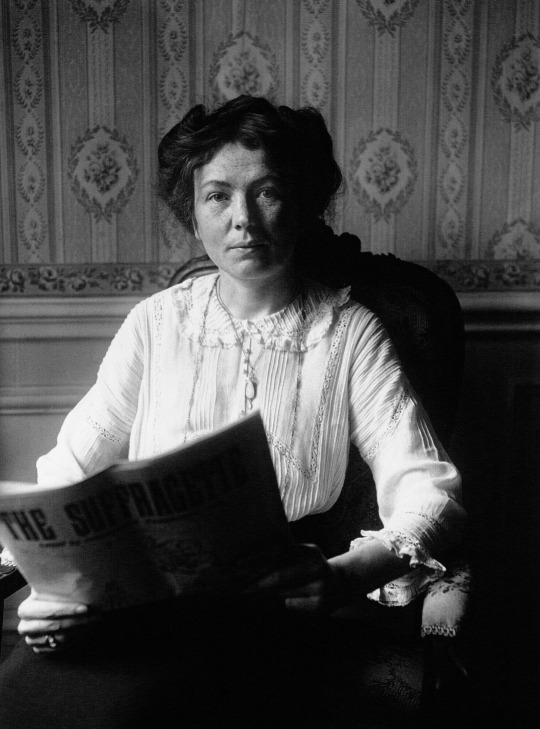
15 notes
·
View notes
Text
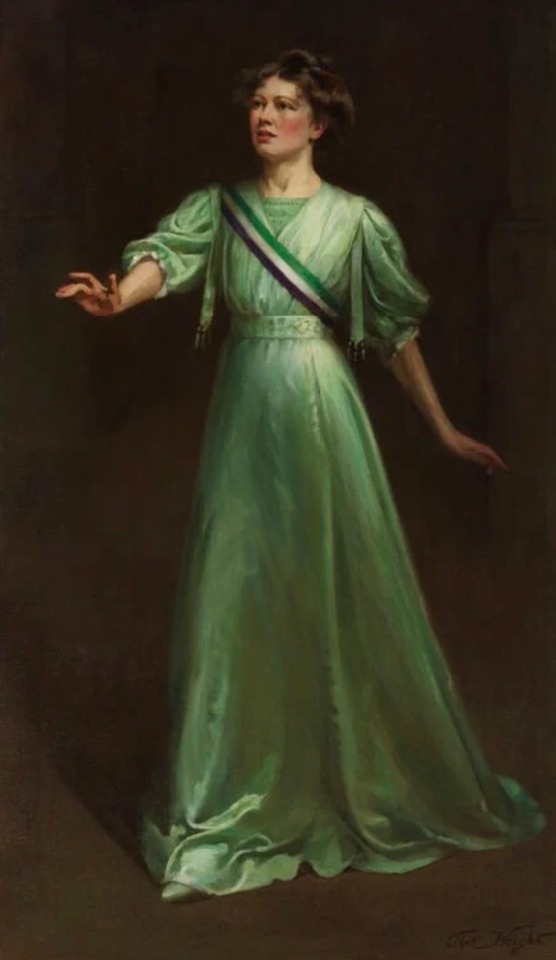
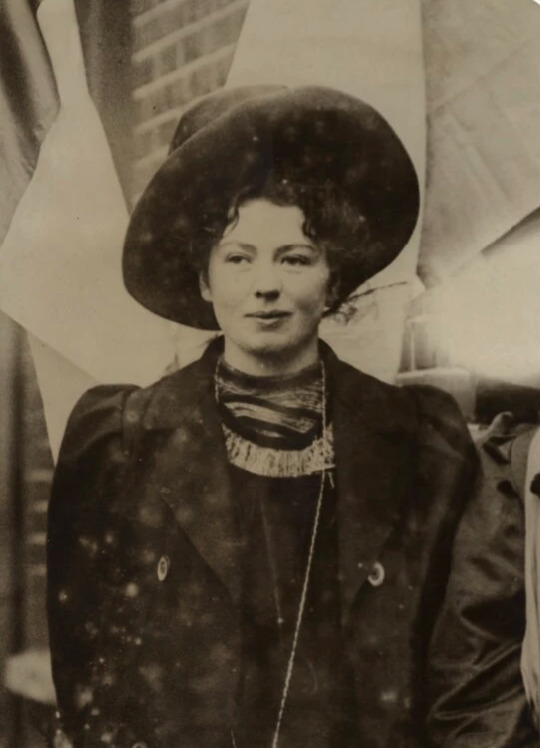
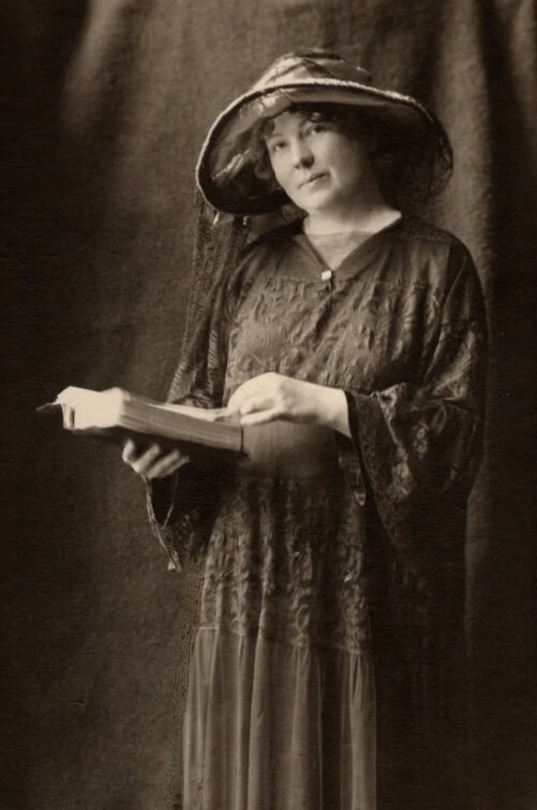
Ethel Wright, Dame Christabel Pankhurst, exhibited 1909
Christabel Pankhurst, by unknown photographer, mid 1900s
Olive Edis, Dame Christabel Pankhurst, 1925-1935
Christabel Harriette Pankhurst, 22 September 1880 – 13 February 1958) was a British suffrage leader. A co-founder of the Women's Social and Political Union, who directed WSPU militant actions from France, while living there in exile. (1912-13) With her mother and sister, she helped women in the UK claim their right to vote.
#christabel pankhurst#women's suffrage#suffrage#the vote#feminist action#feminism#feminist#feminist activism#activism#activists#women rights#womens rights activist#leadership#badass#women in art#women in activism#art history#aesthetictumblr#tumblraesthetic#tumblrpic#tumblrpictures#british history#uk history#tumblr art#tumblrstyle#artists on tumblr#aesthetic
4 notes
·
View notes
Text
"The Daily Telegraph paid a great tribute to the women of Ulster and also to 'the Boer' women in the South African War, whose tactics imposed upon the British generals the cruel necessity of burning the scattered farms of the burghers. We saw from this that burning houses was, in men's eyes, quite justified in the cause of votes for men in South Africa, the issue of which the Boer War had developed, and that militancy on the part of women was admired by men, provided that women were militant for a cause directly affecting men and not in a cause directly affecting women only." [emphasis mine]
—Dame Christabel Pankhurst, Unshackled: The story of how we won the vote, from chapter 16 "1914—Last Year of Militancy" (p. 263; 1959)
#radical feminism#christabel pankhurst#suffrage#the suffragettes#britain#the more things change the more they stay the same
2 notes
·
View notes
Text

2 notes
·
View notes
Text
31/2023: Esther Roper, 4. August 1868
Sie setzte sich für die Rechte von Arbeiterinnen ein und brachte das gender-kritische Magazin Uranie heraus.
By Unknown author, Public Domain
Bereits kurz nach ihrer Geburt in Chorley, Lancashire – ein Ort, der von den nahegelegenen Kohleminen und Textilindustrie geprägt war –, verließen die Eltern von Esther Roper England als Missionare(1). Ihr Vater war ehemaliger Fabrikarbeiter, ihre Mutter stammte aus einer Familie irischer Einwanderer, bei denen Esther aufwuchs. Sie besuchte eine Schule der Church…

View On WordPress
#aktivistys des intersektionalen feminismus#arbeiterbewegung#arbeiterklasse#christabel pankhurst#constance gräfin mankievicz#emmeline pankhurst#esther roper#eva gore-booth#frauenfiguren#george macdonald#irene clyde#kalender#pit-brow lasses#suffragette#sylvia pankhurst#university of manchester#urania#women&039;s suffrage#women&039;s social and political union#wspu
0 notes
Text

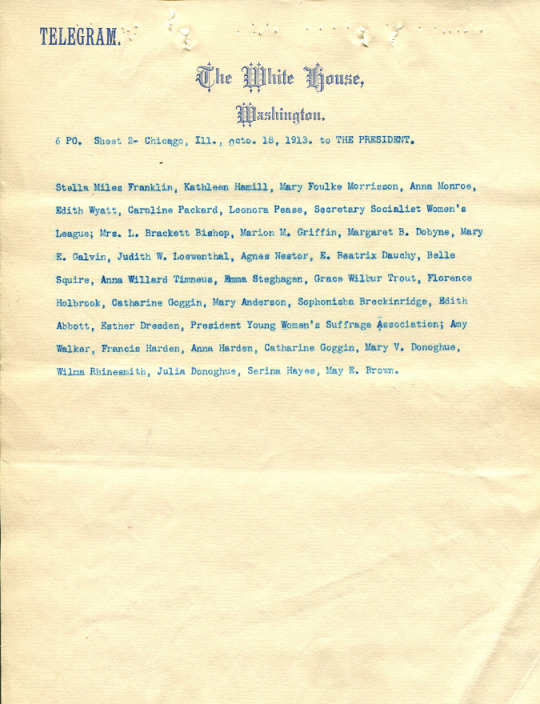
Telegram to President Woodrow Wilson from Jane Addams and Other Women Regarding the Deportation of Emmeline Pankhurst
Record Group 85: Records of the Immigration and Naturalization Service Series: Subject and Policy Files File Unit: Appeal of Mrs. Emmeline Pankhurst for admittance for visit, English Suffragette
This telegram petitioned the Department of Labor and their decision to deport Emmeline Pankhurst, a British suffragette. The authors wanted the board to reconsider and maintain "America's devotion to liberty."
Telegram The White House, Washington 6 PO.FD. 283 139 extra 10:25 p.m. Sa, Chicago, Ill., October 18, 1913. The President. Whereas, the Associated Press reports to the American public that Mrs. Pankhurst's deportation has been ordered by the board of inquiry at Ellis Island and, Whereas, such action is in direct violation of the traditions and customs of the United States which has always been hospitable to the political offenders and revolutionists of all nations, and, Whereas, our sister republic, France, is at the present moment sheltering Christabel Pankhurst, Now, therefore, be it resolved: That we, the undersigned women of Chicago, protest against this flagrant violation of our long established public policy, and, Be it further resolved: That we respectively petition the Department of Labor in reviewing the case of this distinguished English woman to reconsider the decision of the Board of Inquiry and to admit Mrs. Pankhurst; thus maintaining the high traditions of America's devotion to liberty and right of free speech. (Signed) Jane Addams, Louise DeKoven Bowen, Mary Rozette Smith, Mary McDowell, Margaret Dreier Robins, Harriet Taylor Treadwell, President Chicago Political Equality League; Margaret A. Haley, Business Representative Chicago Teachers' Federation; Ida L. M. Furstman, President Chicago Teachers' Federation; Mrs. Harriet S. Thompson, Director Chicago Political Equality League; Edith A. Phelps, Anna Nichols, Laura Dainty Pelham,
Telegram The White House, Washington 6 PO. Sheet 2- Chicago, Ill., Octo. 18, 1913. to the President. Stella Miles Franklin, Kathleen Hamill, Mary Foulke Morrisson, Anna Monroe, Edith Wyatt, Caroline Packard, Leonora Pease, Secretary Socialist Women's League; Mrs. L. Brackett Bishop, Marion M. Griffin, Margaret B. Dobyne, Mary E. Galvin, Judith W. Loewenthal, Agnes Nestor, E. Beatrix Dauchy, Belle Squire, Anna Willard Timneus, Emma Steghagen, Grace Wilbur Trout, Florence Holbrook, Catharine Goggin, Mary Anderson, Sophonisba Breckinridge, Edith Abbott, Esther Dresden, President Young Women's Suffrage Association; Amy Walker, Francis Harden, Anna Harden, Catharine Goggin, Mary V. Donoghue, Wilma Rhinesmith, Julia Donoghue, Serina Hayes, May E. Brown.
49 notes
·
View notes
Text
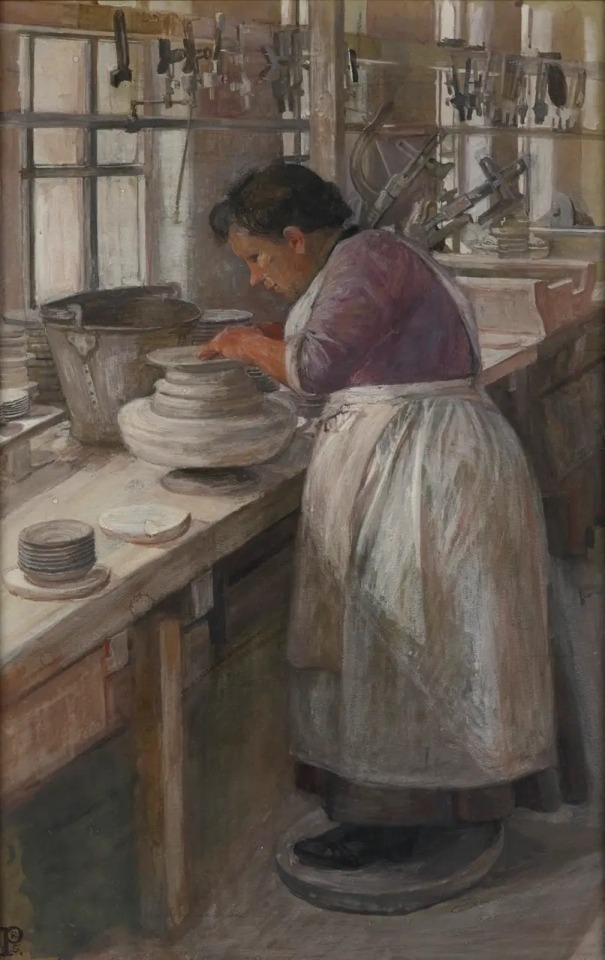
Sylvia Pankhurst - An Old-fashioned Pottery Turning Jasper-ware (1907)
Sylvia Pankhurst’s lifelong interest was in the rights of working women and she made a profound impact on the fight for women’s rights both as an artist and a campaigner. Trained at the Manchester Municipal School of Art and the Royal College of Art, she was a key figure in the work of the Women’s Social and Political Union (WSPU), set up with her mother Emmeline and sister Christabel in 1903, using her artistic skills to further the cause. Pankhurst designed badges, banners and flyers for the WSPU. Her symbolic ‘angel of freedom’ was essential to the visual image of the campaign, alongside the WSPU colours of purple, white and green. As the suffrage campaign intensified she struggled to balance her artistic and political work, and in 1912 she gave up art to devote herself to the East London Federation of Suffragettes, the organisation she founded to ensure that working-class women were represented in the suffrage campaign.
In 1907 Pankhurst spent several months touring industrial communities in Northern England and Scotland, documenting the working and living conditions of women workers. Living in the communities she studied, she painted and wrote about industrial processes and the women who performed them. Her combination of artworks with written accounts provided a vivid picture of the lives of women workers and made a powerful argument for improvement in working conditions and pay equality with men. She painted in gouache, which she found ideal for working quickly under factory conditions. Pankhurst’s detailed account of working conditions and wages was published as an illustrated article, ‘Women Workers of England’, in the London Magazine in November 1908, and as a series of articles on individual trades in the WSPU journal Votes for Women between 1909 and 1911. These highlighted difficult working conditions and the differential between men’s and women’s wages. Her studies of women at work were unusual for the time in their unsentimental observation and their focus on female workers as individuals rather than stock figures in genre scenes, as had been so often the case in British art up to this point. Historian Kristina Huneault has observed that Pankhurst recognised ‘the women’s crucial presence within the industrial arena, their economic agency, their productive activity and their public community’ (Huneault 2002, p.3).
Pankhurst made a number of paintings in the Glasgow cotton mills and also visited the Staffordshire potteries, where she made a group of studies in which she contrasted the working conditions in different factories. As seen in An Old-fashioned Pottery Turning Jasper-ware, she observed how women workers were often restricted to the lower-paid unskilled jobs, working as assistants to the men who performed more skilled and highly-paid operations: ‘In the potteries I also saw the subordination of women workers. A woman was turning the wheel for the thrower, a woman was treading the lathe for the turner: each was employed by the man she toiled for – the slave of a slave, I thought!’ (Pankhurst 1938, p.290.) (source)
71 notes
·
View notes
Text
Mrs Pankhurst, Christabel and Sylvia initially had high hopes of the Labour movement which, unlike other parties, professed itself to be in favour of women's suffrage, but they were to find (as women had been finding in many countries of the world once they claimed the right to vote) that there was a great discrepancy between a commitment in theory and the test of practice. They encountered the argument that there were many more important issues than women's suffrage; these important issues of course related to men.
Keir Hardie was one of the few staunch supporters (if not the only one). Many of the other men - past colleagues of Dr Pankhurst - who came to the Pankhurst house to talk politics were extensively grilled by Christabel on their stand on woman's suffrage, and none of them gave satisfactory answers as far as the Pankhursts were concerned. 'Bruce Glasier,' states Sylvia, ‘far from realizing the new spirit that had taken possession of our home, offended badly. It was not essential, he argued, that the whole people should be enfranchised. So long as the division were not upon class lines.’ An old and familiar argument. But Glasier went further and argued as John Stuart Mill's father had done about eighty years before that ‘those outside the suffrage would be represented by those within; their interests would be the same. There was no distinction of interest on sex, but only on class lines’ (S. Pankhurst, 1931, p. 167). As Anna Wheeler had been enraged by James Mill, the Pankhursts were infuriated by Bruce Glasier and his colleagues: ‘This opinion, common enough amongst Socialists of the time was bitterly resented,’ states Sylvia (ibid.).
Men did not and do not hear what women are saying. So what was to be done? As far as the Pankhursts were concerned they decided it was a waste of energy to keep telling men! If after so many years of discussion and debate, of clear and cogent argument, 'radical' men could persist with their line of reason that women had no specific grievances and what minor 'difficulties' did exist would be ironed out after men had fixed up the world for themselves, one would have to be a dunce or a masochist to pursue a policy of trying to change men's minds. That women should stop talking to men about what was to be done, and start talking to each other, was a strategy that gained in popularity among the Pankhursts over the incident of the Pankhurst Hall.
The Hall had been financed by the appeal launched on Dr Pankhurst's death. The Pankhurst women were quite involved in its construction, with Sylvia giving much of her time to it by assuming the responsibility for its decoration. One can imagine their anger, then, when they found they were not allowed to use Pankhurst Hall, for women were not permitted to become members of that particular branch of the Independent Labour Party. This humiliation was rendered even more galling when they discovered that men who chose not to be members of the ILP, were nevertheless permitted to use it. This was too much: it ‘proved the last straw which caused Mrs Pankhurst to decide on the formation of a new organization of women’, said Sylvia (ibid.). She came to the conclusion that 'she had wasted her time in the ILP' (ibid., p. 68), and she wasn't going to waste it any more. There was nothing else for women to do but to assume responsibility for their own quest for political representation: on 10 October 1903 the Women's Social and Political Union was formed. Sylvia reports that the break with the Labour party was not undertaken lightly by Mrs Pankhurst, and that she was extremely distressed, but under the circumstances she thought women had no choice but to work for themselves.
-Dale Spender, Women of Ideas and What Men Have Done to Them
#dale spender#emmeline pankhurst#christabel pankhurst#Sylvia Pankhurst#womens suffrage#womens history#British history#male hypocrisy#female oppression
19 notes
·
View notes
Text

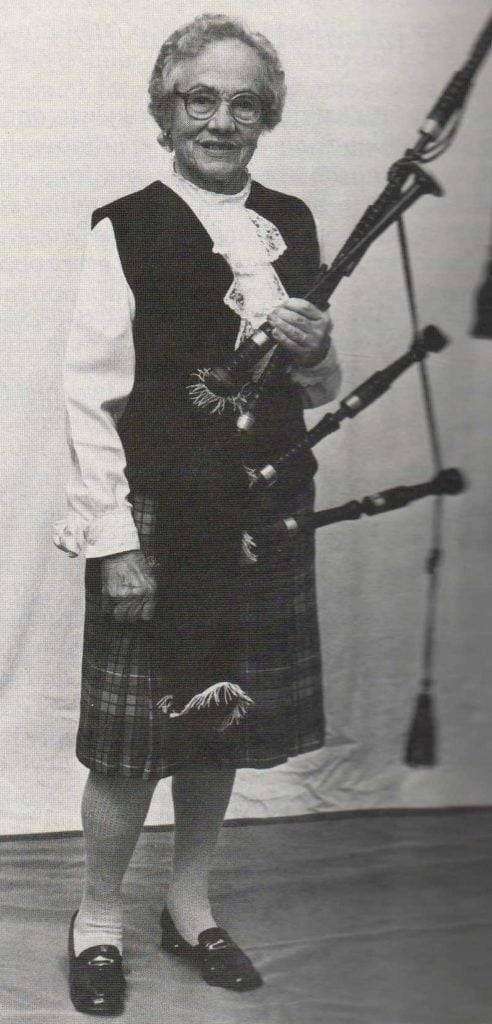
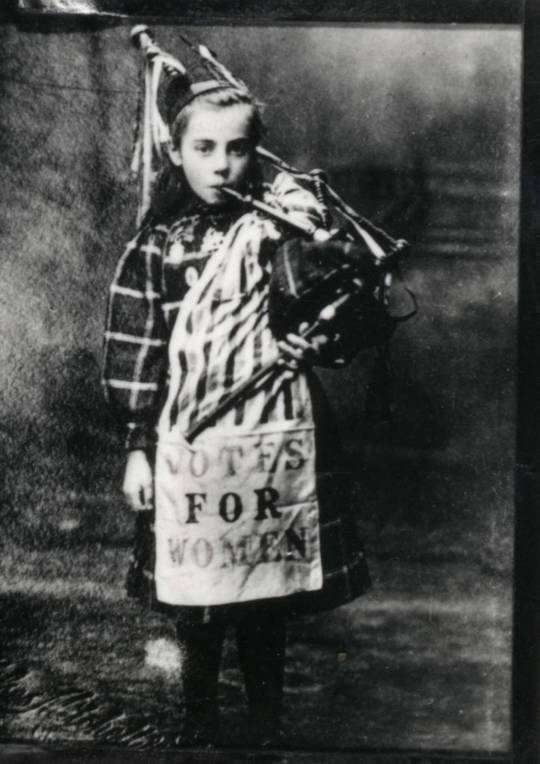
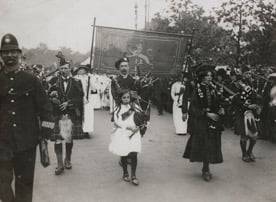

July 13th 1900 saw the birth of Elizabeth “Bessie” Watson in Edinburgh.
Born just off the Grassmarket, at 11 The Vennel to Agnes Newton and Horatio Watson, Bessie did not take long to make her mark in the world, at the tender age of 9 she combined her two greatest loves: bagpiping and woman’s suffrage, the latter makes her arguably the youngest in Scotland, if not the world.
When she turned seven, Bessie’s aunt Margaret contracted tuberculosis – an incident which would change the youngster’s life forever. Margaret lived with the family, and Bessie’s parents, worried that she might fall ill to the contagious disease, encouraged her to take up the bagpipes in a bid to strengthen her weak lungs. Her first set of pipes was specially-produced according to her diminutive stature as she was too small to properly inflate an adult-sized bag. The half-sized set of pipes was purchased from Robertson’s pipe makers at 58 Grove Street. “I hurried home from school and carried it, in a brown paper parcel down to my (music) teacher”, Bessie recalled. As one of the very few female bagpipe players in the world at that time – not to mention one of the youngest – Bessie took to her new instrument with great enthusiasm.
Bessie had more than her bag pipe playing to make her worthy of a post here, while walking with her mother through the streets of Edinburgh, Scotland, Bessie stopped to look at the window of the Women’s Social and Political Union office. Bessie became excited about the idea of women receiving the right to vote, even though she wouldn’t be able to vote for many years.
Bessie realized that her talents could help promote votes for women. She would run from school each day to play her bagpipes outside of the Calton Jail in Edinburgh for fellow suffragettes in prison.
At the first suffrage pageant she performed at, she wore a sash with the words “Votes for Women” as she performed with her bagpipes. At the height of the suffragette movement, Bessie was playing at major demonstrations and parades for the Women’s Social and Political Union, including the famous procession through Edinburgh on 9th October 1909. On that day a large crowd watched as hundreds of banner-laden ladies, wearing the suffragist colours of purple, white and green, marched down Princes Street before congregating at Waverley Market for a rally led by Emmeline Pankhurst. Watson rode on a float beside a woman dressed as Isabella Duff, Countess of Buchan in her cage! Isabella is famed for crowning Robert the Bruce at Scone when he seized the Scottish crown, she was later captured with the Bruce family and held prisoner in a cage in the open air at Berwick for four years.
Back to oor Bessie, who just a ten year-old she travelled to London to play her bagpipes in a women’s march on June 17th, 1911. J ust a few weeks later, for George’s state visit to Edinburgh, Bessie, leading the 2nd Edinburgh Company of the Girl Guides, received recognition from the king himself as she raised her salute. Having secured regal acknowledgement in time for her 11th birthday, Scotland’s youngest female piper continued in her quest to support women’s rights, accompanying inmates bound for Holloway Prison to Waverley Station and playing the pipes as their trains departed.
For the part she played in Edinburgh’s historic women’s rights pageant of 1909, young Bessie received a special gift from one very prominent individual. Christabel Pankhurst (daughter of Emmeline) came to Edinburgh to address a meeting at the King’s Theatre and Bessie was invited to attend. During the evening she was presented with a brooch representing Queen Boadicea (Boudica) in her chariot, as a token of gratitude for her help in the pageant.
During WWI, Bessie was just a teenager and used her talents to make a difference in other ways. She began helping the Scots Guard to recruit army volunteers by playing her bagpipes
In 1926 Bessie moved with her parents to a new house on Clark Road, Trinity where she would remain for the rest of her days. Following her marriage to electrical contractor John Somerville at the end of the Second World War, Bessie devoted her life to teaching music and foreign languages. Former neighbours recall that, even into her late eighties, Bessie continued to play her bagpipes at 11am every morning. It was something she had always done.
Bessie died in 1992, two and a half weeks short of her 92nd birthday. Over the course of her long life she had experienced almost a century of social progression and upheaval, and had played her part in changing the world for the better.
53 notes
·
View notes
Photo

THE LONDON LIBRARY ANNOUNCES HELENA BONHAM CARTER CBE AS PRESIDENT
The London Library is delighted to announce Helena Bonham Carter CBE as its first female President. Proposed by the Library’s Trustees, the appointment was formally confirmed by members at the Annual General Meeting on 15 November 2022, also marking the end of incumbent President, Sir Tim Rice’s five-year term.
The new President has been a Library member since 1986 and has been chosen for her creativity and connections with literature and stories, her high profile and potential to advocate among new audiences.
Bonham Carter has a passion for books and deeply appreciates the importance of writers to the acting profession. Much of her own career links with London Library members who have drawn on the Library’s rich cultural heritage, extensive resources and unparalleled atmosphere. She rose to prominence by playing Lucy Honeychurch in the film adaptation of the novel A Room with a View (1985), written by former Library Vice President E.M. Forster. Later, she played Miss Havisham in Great Expectations (2012), Charles Dickens was a founding member of the Library, and more recently Eudoria Holmes in the Enola Holmes films based on characters created by Library member Arthur Conan Doyle.
Open to all, the Library has had innumerable female artists, writers and thinkers in membership throughout its 181-year history. Early members included pioneering women such as social theorist, Harriet Martineau, suffragette, Christabel Pankhurst and the first woman to qualifiy in Britain and a physician and surgeon, Elizabeth Garrett Anderson. Great writers in membership have included Virginia Woolf, Angela Carter, Daphne du Maurier, Muriel Spark and Beryl Bainbridge, and other creatives such as actress, Diana Rigg, and artist, Vanessa Bell.
The Library Presidency is an honorary position with fundraising and advocacy at its core; the Library is a charity that receives no regular public funding. Bonham Carter’s first major duty will be to host The Library’s Christmas Party but she is particularly interested in the Library’s highly regarded Emerging Writers Programme, its growing schools programme, and the Library’s various types of supported membership for those unable to meet the full annual fee.
The Library is a world-class centre of creativity and inspiration. Around 700 books are published each year by Library members, and over 460 film scripts, TV screenplays or theatre scripts are also produced by Library members annually, estimating an annual value of £21.3m generated for the UK economy (Nordicity and Chartered Accountants Saffrey Champness Impact Report, 2020).
Helena Bonham Carter CBE, said: “I am delighted to become The London Library’s first female President and to champion an institution that is open to all. The Library is truly a place like no other, inspiring and supporting writers for over 180 years, many of whom have in some way informed my own career and those of actors everywhere. The Library’s unique resources, history and membership help to connect the literary greats of the past with those of the future, and I am proud to support this incredible and vital establishment.”
Philip Marshall, Director of The London Library said: ‘We are all thrilled to welcome Helena Bonham Carter as our new President. With a passion for books and stories, and a long-standing love of the Library, Helena is ideally placed to promote this tremendous resource for the creative and curious.’
Photo credit: Sane Seven
#news#helena bonham carter#the london library#2022#sane seven 2022#photoshoots#photoshoots: 2022#the hbic stays winning 👑
63 notes
·
View notes
Photo

11 notes
·
View notes
Text

I love this. I love that Christabel Pankhurst is being quoted approvingly in Buckingham Freaking Palace
#and not by just anyone! by the literal queen of england!!!#shoutout to women in general tbh#queen camilla
6 notes
·
View notes